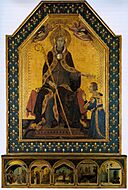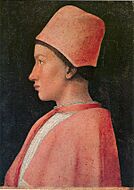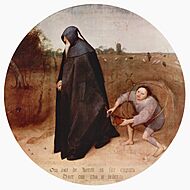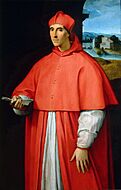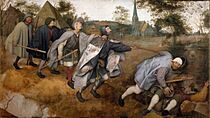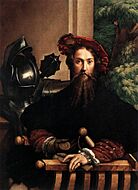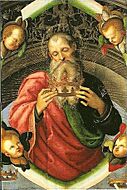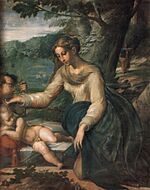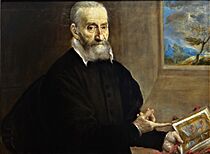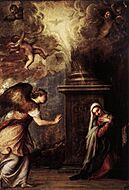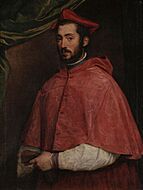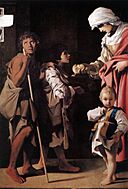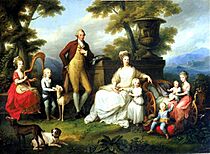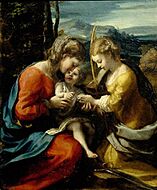Museo di Capodimonte facts for kids

Palace of Capodimonte
|
|
| Established | 1757 |
|---|---|
| Location | Via Miano, 2 80131 Naples, Italy |
| Type | Art museum, Historic site |
| Visitors | 193 055(2016) |
The Museo di Capodimonte is a fantastic art museum in Naples, Italy. It's inside a beautiful old palace called the Palace of Capodimonte. This palace was built by the Bourbon royal family. The museum is a top spot to see amazing paintings and decorative art from Naples. You can also find important ancient Roman sculptures here. It's one of the biggest museums in Italy. The museum officially opened its doors in 1957.
Contents
The History of Capodimonte Museum
How the Royal Palace Became a Museum
The amazing art collection at the Museo di Capodimonte started a long time ago, in 1738. King Charles VII of Naples and Sicily (who later became Charles III of Spain) first wanted to build a hunting lodge on Capodimonte hill.
But then, he changed his mind. He decided to build a grand palace instead. One reason was that his current home, the Palace of Portici, was too small for his royal court. The other big reason was to house the incredible Farnese Collection. This collection of art was inherited from his mother, Elisabetta Farnese. She was the last person from the royal family of Parma.
Over many years, the palace grew bigger and more art was added. In 1787, a special workshop was created to fix and restore paintings.
Art During Times of Change
In 1799, there was a big change in Naples called the Parthenopaean Republic. King Ferdinand IV had to leave Naples and sail to Palermo. He took the most valuable art pieces with him to keep them safe.
French soldiers then took over the palace and stole some of the art that was left behind. Later, from 1806 to 1815, the French ruled Naples. During this time, the art collection was moved to the Naples National Archaeological Museum.
When King Ferdinand came back in 1815, he hired many artists to redecorate the palace. It was finally finished in 1840. A new section was added to show modern art.
New Art and a National Museum
In 1861, the palace became part of the House of Savoy family. They added even more art to the collections. They also brought in a large collection of old firearms and other weapons.
In 1866, a special room called the boudoir of Maria Amalia of Saxony was moved to Capodimonte from the Palace of Portici. In 1877, an ancient Roman marble floor was brought from a Roman villa on Capri.
After the monarchy ended, the palace officially became a national museum in 1950. Many of the art pieces that had been moved were brought back to Capodimonte.
What You Can See at the Museum
The National Gallery of Art
The first and second floors of the museum hold the Galleria Nazionale, which means National Gallery. Here, you can see paintings from the 13th to the 18th centuries. There are famous works by artists like Caravaggio, Raphael, Titian, El Greco, Giovanni Bellini, and many others.
This museum is the best place to see paintings from the Neapolitan School. These are artworks made by artists from Naples. You'll find many pieces by Jusepe de Ribera and Luca Giordano.
Ancient Sculptures and Royal Rooms
On the ground floor, you'll find a large part of the amazing Farnese collection. This includes many ancient Roman sculptures. These sculptures are still mostly complete and can be seen here and at the Naples National Archaeological Museum.
In other parts of the palace, you can explore the royal apartments. These rooms are decorated with beautiful 18th-century furniture. There's also a collection of porcelain and majolica (a type of pottery) from the royal homes.
In 2022, an art dealer named Lia Rumma gave more than 70 artworks to the Italian government. These pieces, made by 30 important Italian artists, are now shown at the Museo di Capodimonte.
Amazing Art Highlights
-
Toulouse Altarpiece by Simone Martini, around 1317
-
Crucifixion by Masaccio, around 1426
-
Portrait of Francesco Gonzaga by Andrea Mantegna, around 1461
-
Madonna and Child and Two Angels by Botticelli, around 1470
-
Transfiguration by Giovanni Bellini, around 1480
-
The Misanthrope by Pieter Bruegel the Elder, around 1568
-
Portrait of Cardinal Alessandro Farnese by Raphael, around 1509–1511
-
The Parable of the Blind Leading the Blind by Pieter Bruegel the Elder, around 1568
-
Antea by Parmigianino, around 1524–1527
-
Pope Paul III and his Grandsons by Titian, around 1546
-
Madonna and Child with Saint Peter Martyr by Lorenzo Lotto, around 1503
-
Baronci Altarpiece by Raphael, around 1500–1501
-
Holy Family with St. John by Parmigianino, around 1528
-
A Boy Blowing on an Ember to Light a Candle by El Greco, around 1570–1572
-
Portrait of Giulio Clovio by El Greco, 1571
-
The Annunciation by Titian, around 1557
-
Portrait of Pope Paul III by Titian, around 1543
-
Portrait of Cardinal Alessandro Farnese by Titian, around 1545–1546
-
Charity by Bartolomeo Schedoni, around 1611
-
Ferdinando IV and His Family by Angelica Kauffman, around 1783
See also
- List of largest art museums


